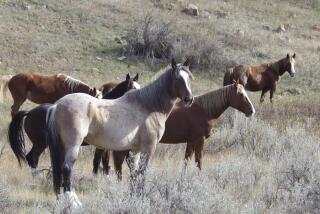Saving the Wild Horses
- Share via
The loophole was big enough to drive a herd of wild horses through. On the other side, too often was the front door of a slaughterhouse. A few lucky mustangs wound up as rodeo stock. The unlucky ones were sold for meat.
The Times’ Ronald B. Taylor disclosed earlier this year how ranchers were able take advantage of the federal government’s wild-horse adoption program to win title to thousands of horses without paying the $125-a-head fee. The animals then would be sold in violation of the spirit and letter of the law, which prohibits economic exploitation of the herds.
This month the U.S. Bureau of Land Management wisely suspended the fee-waiver arrangement and said it will work to increase individual horse adoptions and study the development of privately funded wild-horse sanctuaries in the West.
What to do about the West’s estimated 43,000 wild horses is not an easy problem with any easy solution. The roaming mustangs compete with cattle and sheep on open grazing land leased by ranchers from the Bureau of Land Management. Such leases often have been in families for decades, and in many areas leased federal land is considered an integral part of a ranch. In the old days, the wild horses routinely were shot or rounded up and sold for pet food.
The Bureau of Land Management launched its adoption program several years after Congress protected wild horses--the offspring of domestic horses that were set free over the years for one reason or another--in the early 1970s. But in recent years, only about a third of the best animals have been adopted. The culls left over in BLM corrals after the yearly roundups tend to be older, wilder and the least attractive. The government now spends about $17 million a year to feed them.
The mass fee-waiver program made sense only if the probable ultimate fate of the horse was ignored. Ranchers would feed the animals on their own land, thus saving the federal government the expense. Bureau officials claimed they did not know what happened to the horses after the one-year waiting period for a title. The probable outcome should have been obvious, however.
Bureau of Land Management officials say the range probably could support about 30,000 wild horses without causing undue damage to the land. The new program of promoting the individual adopt-a-horse program in the East might help. So, too, would donation of private land as sanctuaries. Of course, something would have to be done to keep the mustangs from straying back onto the federal leased range, but fencing of such vast expanses is prohibitive. But it also does not make much sense for the BLM to be in the horse-ranching business, keeping unwanted mustangs confined to corrals and fed at public expense.
Credit Bureau of Land Management officials for seeking creative solutions. But in the case of the mass fee waivers, fault them for having their Stetsons pulled down to the bridges of their noses.
More to Read
Sign up for Essential California
The most important California stories and recommendations in your inbox every morning.
You may occasionally receive promotional content from the Los Angeles Times.










